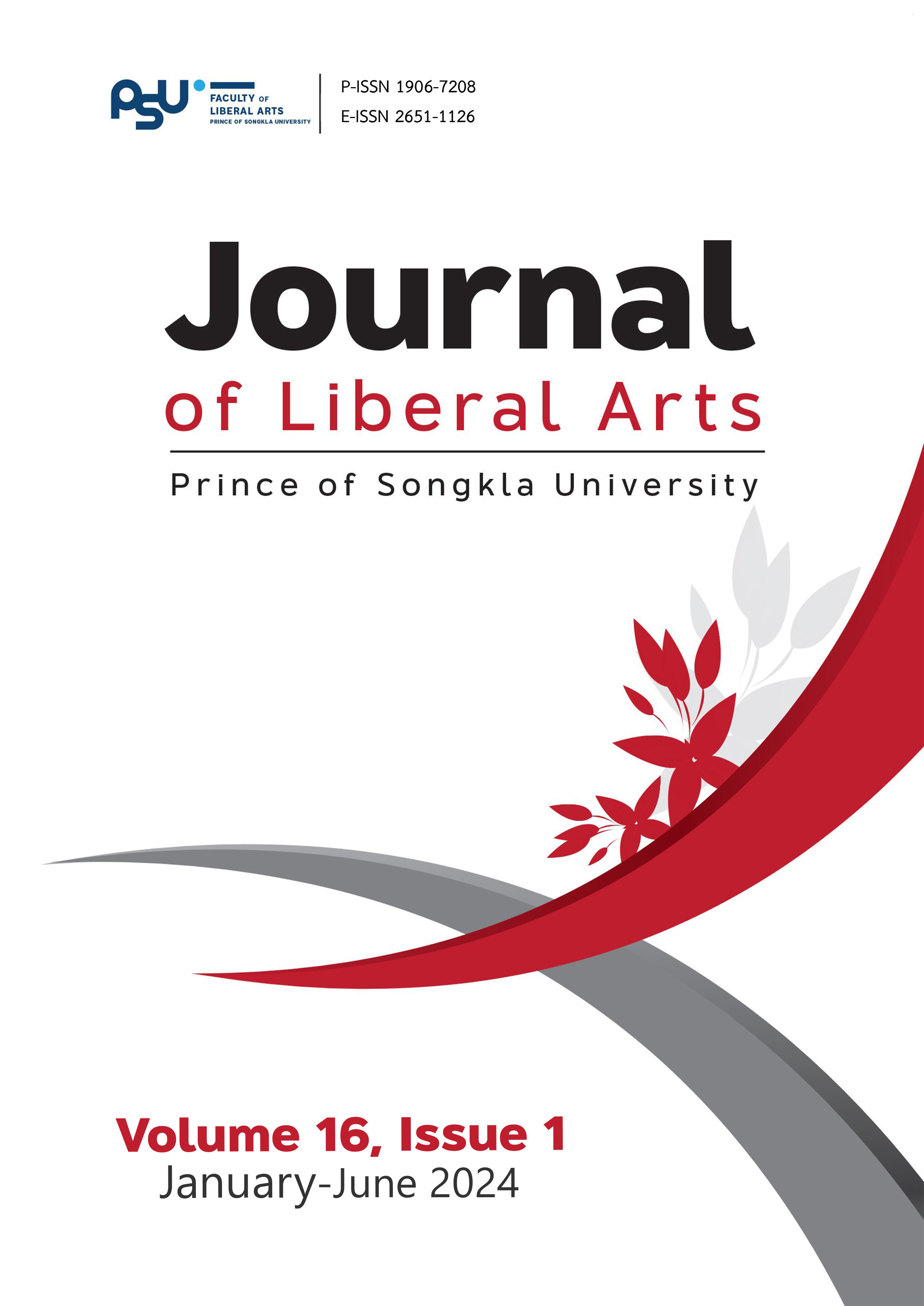Problem and Need Analysis for English–Chinese Manual Development for Service Providers in Healthcare Establishments in Khanom District, Nakhon Si Thammarat Province
DOI:
https://doi.org/10.14456/jlapsu.2024.7Keywords:
Language Problem, Healthcare Establishments, Manual, Need Analysis, Service ProviderAbstract
Creating value in healthcare requires developing English and Chinese language skills among service providers. This research aimed to
1) investigate English and Chinese language problems and needs among service providers in Khanom District healthcare establishments;
2) develop an English-Chinese manual; and 3) assess the service providers’ satisfaction with the manual. The study involved a purposive sampling of 60 service providers from healthcare establishments in Khanom District, Nakhon Si Thammarat. The research employed a questionnaire addressing problems and needs, a satisfaction assessment form, interview forms, and an English-Chinese communicative manual. Data analysis methods included percentages, means, standard deviations, and content analysis from interviews. The findings revealed that problems related to the English language among healthcare providers in Khanom District were notably high (= 4.01), encompassing all language skills. Similarly, problems in using the Chinese language were at the highest level
( = 4.96). The sample group exhibited a significant need for English skill development, with speaking skills being the most problematic (
= 4.73). On the other hand, the overall demand for Chinese language proficiency was at a moderate level (
= 2.86), with the greatest need being for speaking skills (
= 3.60). The overall satisfaction assessment of the English-Chinese communicative manual was highly favorable (
= 4.05). The results of this research could be used as a guideline to develop English and Chinese language training programs for healthcare professionals in their workplace.
References
Akrawong, S., Kingkaew, R., Petchkit, C., & Jinphon, P. (2018). Developing health tourism of Nakhon Si Thammarat province to be a health tourism center of the southern region. [Research report]. Thailand Research Fund.
Benesch, S. (1996). Needs analysis and curriculum development in EAP: An Example of a critical approach. TESOL Quarterly, 30(4), 723-738.
Chaisuvan, C., & Chantachon, S. (2018). Service provider development model in healthservice of the union of Thai traditional medicine society. Journal of MCU Peace Studies, 6(1), 188-199.
Chiablaem, P. (2020). A need analysis of Thai massage employees’ (Thai massage therapists, receptionists, and managers) English communication skills in the city of Pattaya, Chonburi. rEFLections, 27(2), 274- 292.
Chusri, W., & Lalitsasiwimon, W. (2020). Health tourism: Thailand's competitiveness. Narathiwat Rajanagarindra University Journal Humanities and Social Sciences, 7(2), 205-226.
Day, J., & Krzanowski, M. (2010). English for specific purposes: An introduction. Cambridge University Press.
Department of Health Service Support. (2021, April 12). Report on the number of establishments in the area. http://spa.hss.moph.go.th/report_spa/report_shop_1.php?Z=111&fbclid=IwAR0nS7W_V_C9I6isV2GSm_oAy0Ry81Biv5AmkO5MyEyamHIGnIfv7kTGQKc
Dudley-Evans, T., & St. John, M. J. (1998). Developments in ESP: A multidisciplinary approach. Cambridge University Press.
Global wellness institute. (2017). The global wellness tourism economy 2017. http://www.globalwellnesssummit.com.
Global wellness institute. (2018, November). Global wellness tourism economy: Asia-Pacific. https://globalwellnessinstitute.org/industry-research/asia-pacific-wellness-tourism/
Graves, K. (2000). Designing language courses: A guide for teachers. Heinle & Heinle, Thomson Learning.
Hutchinson, T., & Waters, A. (1987). English for specific purposes: A learning centered approach. Cambridge University Press.
Khakhai, K. (2014). English language needs analysis of Thai massage therapists at spas on Khaosarn Road, Bangkok. Thammasat University.
Likert, R. (1967). Attitude theory and measurement. John Wiley & Son.
Ministry of Tourism and Sports. (2021a, April 12). Statistics of foreign tourists traveling to Thailand. https://www.mots.go.th/old/more_news.php
Ministry of Tourism and Sports. (2021b, April 12). World business and ASEAN health tourism. https://millionaire-academy.com/health tourism
Nakhon Si Thammarat Provincial Statistical Office. (2022). Statistics of foreign tourists traveling to Nakhon Si Thammarat. https://gdcatalog.go.th/dataset/?organization=58784344-1f3b-4290-b9b7-9df342d3dac2
Nakhon Si Thammarat Provincial Tourism and Sports Office. (2021, April 12). Number of tourists and income from tourism. https://nakhonsi.mots.go.th/more_graph.php
Office of the National Economic and Social Development Council. (January, 2024). Master plan under the national strategy. http://nscr.nesdc.go.th/master-plans/
Patanasorn, C., Patanasorn, A., Kosittakun, S., & Porewanna, S. (2018). English needs in spa and massage shops: perspectives of customers, therapists, and receptionists. Eurasian Journal of Analytical Chemistry, 13(3), 349-356.
Rajan, B. R. S. (2001). Designing and teaching an ESP course for officials from the finance sector in Cambodia, Lao PDR, and Vietnam. in. [Paper presentation]. The English language teaching and learning at the tertiary level: From past to present and future trends, Chulalongkorn University, Language Institute.
Robinson, P. (1991). ESP Today: A Practitioner’s Guide. Prentice Hall.
SCB Economic Intelligence Center. (2021, April 10). Wellness tourism: opportunities for the tourism business. https://marketeeronline.co/archives/21776.
Sriyawong, J., Saiduang, P., & Pitikornpuangpetch, C. (2016). A development of activity package promoting communicative English skill for traditional Thai massseurs in Ubon Ratchathani province. Humanities and Social Sciences Journal, Ubon Ratchathani Rajabhat University, 7(2), 227- 241.
Sukpatcharaporn, N. (2018). The development of English lessons to promote English speaking skill of traditional Thai masseurs in Doi Saket district, Chiang Mai province. [Research report]. Chiang Mai Rajabhat University.
Sukserm, T., Suwanbubpha, S., & Kunto, S. (2017). The need for English in the work of medical personnel in hospitals in Kalasin Province. [Research report]. Kalasin University.
Tourism Authority of Thailand. (2021, April 12). Health tourism. http://www.elfhs.ssru.ac.th/alisa_ri/file.php/1/1._N.pdf
Walailak University. (2019, August 8). Mowalailak wichai sang atta lak lae yok radap mattrathan borikan sapa si wichai. (in Thai) [Walailak university researches creating identity and raising the standard of Sriwichai spa services]. https://www.wu.ac.th/en/news/16458
Wang, H., & Jiang, S. (2019). Chinese for specific purposes: A broader perspective. In C. R. Huang, Z. Jing-Schmidt, & B. Meisterernst (Eds.), The Routledge handbook of Chinese applied linguistics (pp. 407–421). Routledge. https://doi.org/10.4324/9781315625157
Waowaew, S. (2021). Chinese language skill development in working as Thai traditional masseuses. Journal of SaengKhomKham Buddhist Studies, 6(2). 269-286.
Downloads
Published
How to Cite
Issue
Section
License
Copyright (c) 2024 Ladawan Jantawong, Rachawadee Chanthong, Patchayapa Thongsai

This work is licensed under a Creative Commons Attribution-NonCommercial-NoDerivatives 4.0 International License.
The authors retain the copyright to their article but the Journal of Liberal Arts, Prince of Songkla University reserves the exclusive rights to first publication.






